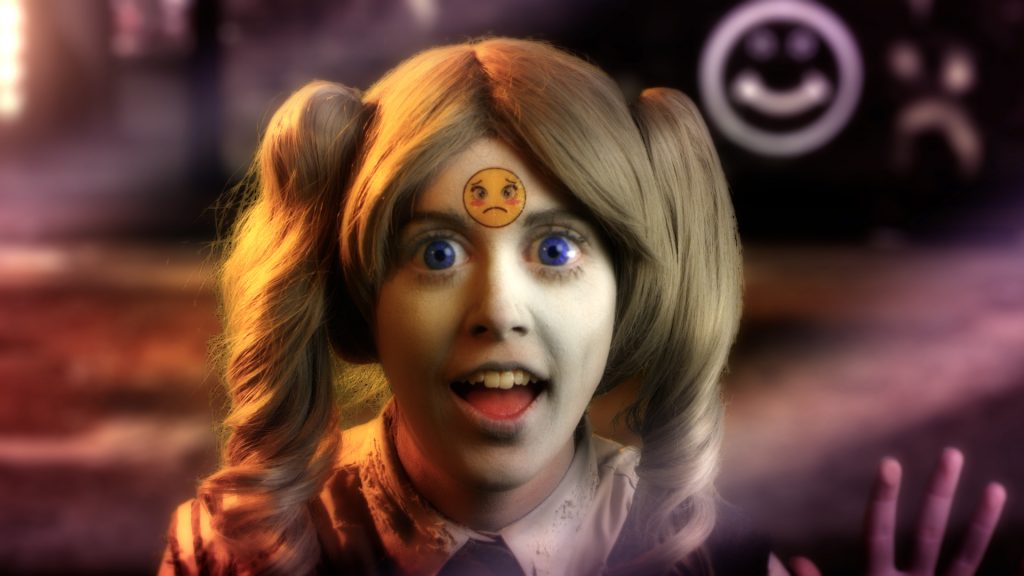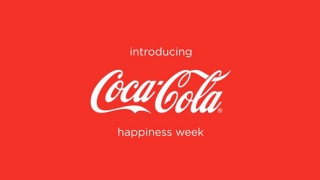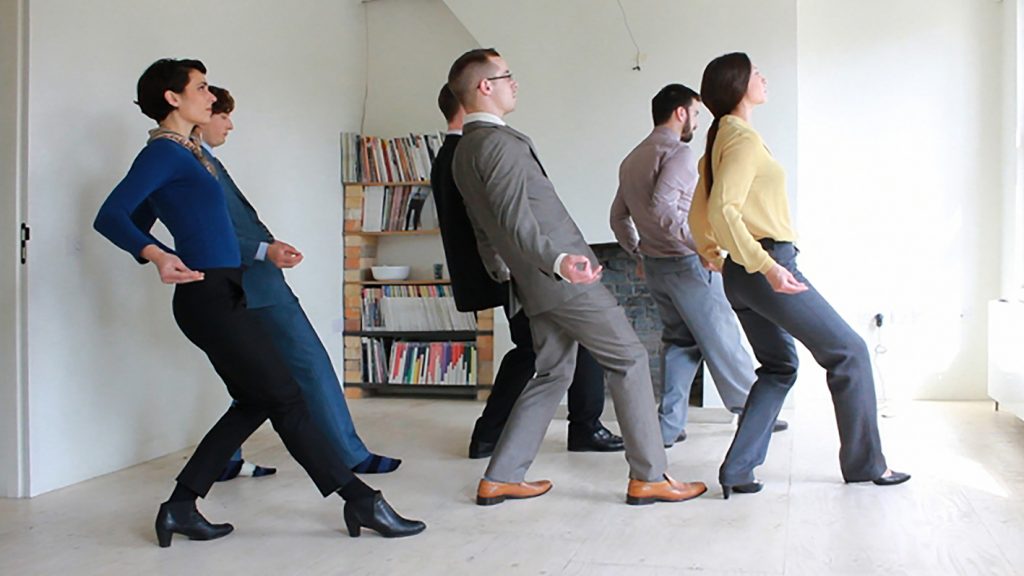
Rachel Maclean’s new video installation in the British Art Show 8, Feed Me, Scene 1 (2015), is a dystopian vision of a city where consensual surveillance, based on visual and consumptive evidence, is used by the corporate director of Smile, Inc. to quantify, optimise and sell happiness and productivity to its youth. Children complete customer satisfaction forms – here a gleeful leisure – written semi-literately in web acronyms rendered in Comic Sans font. The required response to questions such as ‘Do U trust d company 2 take care of u?’ or ‘Based on ur awareness of d product, iz it cuter thn othr brands?’ is a click on either a smiley emoticon or a sad emoticon – abstractions of emotional states indexed against patterns of consumption and trust.
After the hour-long work looped out I staggered out of the installation, pawing the luxurious pink carpet pile, assaulted by its sonic-visual forcefulness, distressed and destabilised by the manic polarities hammered out by Maclean, killed by cuteness. Cuteness, critic Sianne Ngai has suggested, is a pastoral aesthetic that indexes our desire for simpler relations to commodities. In Maclean’s Feed Me, Scene 1 terminal cuteness of a kind with happiness blunts feelings, finally raizing the city. Like all great dystopias, the seeds of a plausible future are already all around us in our day-to-day life. You will, no doubt, have seen the Coca-Cola advertisements on buses: #ChooseHappiness reads the tagline beneath an image of a tin of carbonated soft drink – a sickly confluence of product, brand, choice, emotional state and data curation. As the nation watched The Great British Bake Off, a programme by Love Productions which invites you to ‘bake yourself into happiness’, the Office for National Statistics published its biannual autumn report on national well-being. While 40.9% of people rated their anxiety yesterday as very low, 34.1% rated their happiness yesterday as very high – an improvement on last year.].

Coca-Cola, now registered owners of the slogan ‘Choose Happiness’, recently inaugurated annual Happiness Week, employing vloggers across YouTube channels to – in hippy-ish parlance – ‘spread good vibes’. On the website an infographic showing what makes parents and teens happy eclipses the product; you would be forgiven for thinking that you had rerouted to the charity Mind or to NHS Choices. Here, the conventional product as we know it, a can of Coca-Cola, is entirely eclipsed by happiness, but this, of course, is the product. Depression is more serious than a sugar slump: many can’t #ChooseHappiness. These days I tell every bus I see to fuck off, despite its cheerful message. Maclean’s video accelerates this unwelcome breaching into the biopolitical, hypertrophying it – it is a plea for complexity.
Happiness is not simply the benign concern of the state. Nor is it, William Davies writes in his recently published book The Happiness Industry, ‘some pleasant add-on to the more important business of making money, or some new age concern for those with enough time to sit around baking their own bread’. As a measurable, visible, improvable entity, happiness, he continues, has penetrated practices of global economic management. As such, techniques, measures and technologies for combatting stress, misery and illness now permeate the workplace, the high street, the home and the human body. Happy, healthy people = productive, profitable people. Symptomatic of this, for Davies, was when, last year, Matthieu Richard, the French translator of the Dalai Lama, began daily sessions at the World Economic Forum in Davos with workshops on mindfulness and meditation. Indeed, only last month the Dalai Lama himself backed Action for Happiness, a London-based organisation, funded by Kickstart donations, offering eight-week courses on happiness.

NOT HAPPY (2014), by Benedict Drew, signposts a seething nihilistic misanthropy familiar to many of his video installations. Nearing the end of NOT HAPPY (2014), his characteristically hallucinatory video work, screened at the Serpentine’s ‘Extinction Marathon: Visions of The Future’ last year, a morphed refix of Pharrell Williams’s neo-soul track Happy (2014) blears over stock images of a clean kitchen. ‘WHY ARE YOU SO HAPPY PHARRELL?’ reads an intertitle superimposed over a rubberised mask. It’s followed by another, graver: ‘WE’RE ALL GOING TO DIE.’ Drew recently told me that the track’s pervasiveness seemed as though some sort of law had been passed that meant all the loudspeakers in the land had to play the song on a loop all day, every day. Drew’s video implicates viewers in an ecological crisis by re-presenting liberal sanctimonious platitudes of ‘not me’: landfills brim with plastic, but you and I are all right. The waste of consuming our way to individual happiness, of having everything, is a problem for everyone. ‘Happiness,’ said the Dalai Lama, ‘is not something ready made. It comes from your own actions.’ If you clap along enough with Pharrell you might just find happiness. What structural violence, Drew’s video asks, are being obscured when the imperative for happiness lies with the individual rather than the collective?
Drew’s ‘Onesie Cycle’ & ‘Onesie Cycle VIP’, exhibited simultaneously at 2 Queens and the Phoenix cinema, Leicester, in 2013, ingested the viewer into the high street’s toxified interior: Primark, payday loan companies and KFC chicken, PPI call centre staffs’ compassion finessed. ‘Self Help’, reads cheerful glowing text on a screen. In the Phoenix, posters scrawled with nebulous self-help guidance read as if generated by an ‘intelligent’ corporate twitterbot. Drew returns all this to the body. The onesie referred to in the title is not just an infantilising garment, it is the skin of the body, the largest human sensory organ. Skin onesies, flayed bodies, hang from the gallery walls like pelts. Lumps of flesh spin on rotating platforms around a frail, malnourished figure barely even there. ‘In XTC’, projected on the greasy base of a KFC bargain bucket, suggests a euphoric loss of self, not through ritualistic transcendence, not even through popping happy pills, but addiction to high-fat/high-sugar foods such as chicken and Coca-Cola, and a real-time feed of social media. Euphoria nonetheless, but what does it do to the body? To what extent is this loss of self a loss of political agency?
In his long out-of-print book Mindfuckers: A Source Book on the Rise of Acid Fascism in America, 1972, David Felton sensed the vibes turning nasty in the wake of the hoped-for acid revolution, where boredom, loneliness and intense spiritual hunger nurtured a burgeoning cult problem in the US. In 1978 the Jonestown massacre brought mind control into the public consciousness. For Drew the vibes got nasty in the UK when counterculture’s lessons were learned by neoliberal capitalists. CEO-hippy hybrids, such as Richard Branson, the subject of Drew’s recent exhibition ‘KAPUT’ at Derby QUAD this summer, supplemented corporate speak with good vibrations. As an undergraduate student Branson had already interviewed the doyen of anti-psychiatry, RD Laing.
Today, the growing adoption of alternative models of mindfulness and meditation in the workplace is, I would argue, an expression of Silicon Valley’s global tech export. Such alternative models are the bedrock of the West Coast lifestyle. Google’s appointment, for instance, of the office ‘jolly good fellow’ or corporate in-office mindfulness stress reduction clinics at Capitol Hill have a genealogy that can be traced back to at least the 1960s, between The New Age Movement and The Human Potential Movement. Whereas the latter, according to Suzanne Snider in her Believer essay ‘EST, Werner Erhard, And the Corporatization of Self-Help’, repeated the individual as the sole determiner of his or her own experiences, NAM explored spiritual, metaphysical, and extraterrestrial realms as forces guiding and even determining a person’s life.

In 2012, when massage and yoga was briefly poised in the practice of contemporary artists, from Oscar Murillo to Nicole Morris, it was as much an expression of its growing popularity as a leisure activity in gentrified neighbourhoods as its application in corporate management styles. Yoga bends both ways: leisure and work. On the continent, new management styles and certain cliches of Silicon Valley innovators have fascinated artists such as Simon Denny and Daniel Keller. Earlier this summer, on the US West Coast, Karl Holmqvist and Ei Arakawa’s Y.O.Y.O.G.A.L.A.N.D. at Overduin & Co explored the relation between counter cultural utopianism and contemporary new ageism. Almost contemporaneously, Drew Heitzler’s ‘Pacific Palisades’ at Blum & Poe unearthed the degrees of separation between bad acid trips, visionary thinking and technological innovation in that region of the West Coast during the 1960s. In the UK, I would argue this has manifested in a growing interest in the question of happiness, the occult and corporate group dynamics. Last year at FACT, Liverpool, Vanessa Bartlett co-curated ‘Group Therapy: Mental Distress in a Digital Age’ at FACT, Liverpool; in the accompanying publication of the same title Bartlett writes that the show was conceived as a response to issues specific to late capitalism and our technologically driven society. ‘We,’ she goes on, ‘live in a society that prioritises political objectives over the thoughts and feelings of individuals who suffer the consequences of policy and economic objectives.’
The teachings of HPM inform the dramaturgy of Lucy Beech and Edward Thomasson’s collaborative performances and video works such as Holding it Together, 2011, Left Behind Together, 2013, Open House, 2012, and Passive Aggressive 2, 2014. Casting a wry eye over the neo-liberal prerogative to ‘be who you are’, in mind, body and spirit, their individual and collaborative work evokes exactly the incorporation of alternative and counter cultural ways of being together into corporate management styles and institutional mental health and wellbeing. For the past three years, Beech’s own video works, such as Results that Move You, 2015, have developed out of embedded research into franchised well-being workshops and pyramid schemes, emotional labour and the internal mechanics of affective economies, such as contemporary funeral custom.
Thomasson’s works, which draw heavily upon musical theatre – a synthesis of acting, composition and choreography – are constructed fictional narratives which nonetheless sample familiar situations and themes such as anti-social behaviour, sexual intimacy or consumer focus groups. His video work The Present Tense, 2014, shown last year at London’s Chisenhale Gallery, layers three seemingly disparate stories: an art therapist’s sessions with a young boy; police officers singing about stop-and-search to a sniggering group of teenagers; and a woman’s attempts at mindfulness.
In their collaborative performance Open House, 2013, an estate agent leads a group around a flat to a soundtrack of ‘chill out’ music until, finally, it is revealed that this music is performed by an all-dancing, all-singing group of estate agents concealed in the living room. These estate agents, we imagine, have broadened their skillset to become the ‘new artisans’ of our capitalist economy that places a premium on personal interaction, flexibility and adaptability in order to offer services which are uniquely human. It is an economy which social psychologist Philip Boxer describes as, ‘liberating individual entrepreneurial freedoms and skills within an institutional framework characterised by strong private property rights, free marketers, and free trade’. Today, a generally aestheticised lifestyle is the new norm, it is the way in which we begin to see what our new artisanal tech economy has not only learned from new ageism or HPM, but also from contemporary art.

A critique levelled at relational aesthetics was that it operated within, perhaps augured, what Isabelle Graw called the communication imperative of contemporary post-capitalism. Dissatisfaction with the consensual surveillance of network capitalism, coupled with despair at the power of the market to commodify our discontent, have understandably led artists back to the human body. But what of the mind in an age increasingly oriented to mindfulness? In ‘The Mindfulness Racket’, published last year in The New Republic, Evgeny Morozov wrote of how mindfulness is becoming the ‘new sustainability’ among the accelerationist-distractionist complex that is Silicon Valley.
If, however, Morozov argues, we must disconnect to re-energise, it must not be to re-invest with renewed vigour in yet more distraction. If healthy bodies and minds equals healthy profit, is it an option to become unhealthy – eat the shit that Drew is both repulsed and fascinated by? How do we click the unhappy emoticon – in other words, #ChooseNotToChooseHappiness? In an age of entrepreneurialism of the self, where happiness promotes increased productivity, perhaps it is time to adopt what I’ve heard the artist Richard Sides call the ‘new un-professionalism’?
Listen to me discuss this article on the Art Monthly Talk Show, Resonance FM, along with guests Jamie Sutcliffe and Lauren Velvick, and presented by Chris McCormack.
